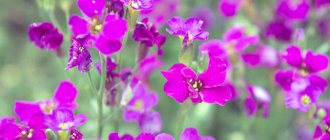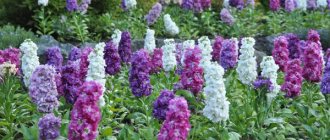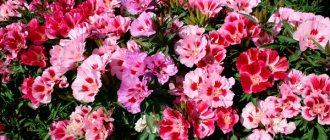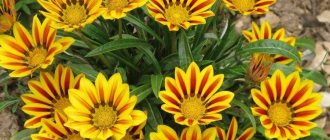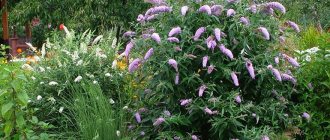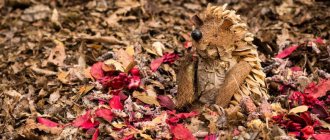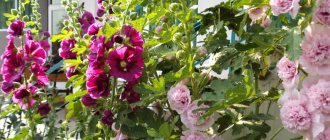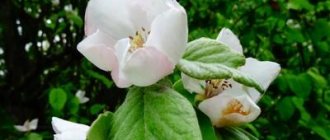23196
Hydrangea bushes are deservedly considered one of the best options for garden design. Lush inflorescences of various shades are difficult to miss against the background of foliage. You want to admire such beauty again and again. If you want to enjoy the delicacy of a new variety, but have nowhere to take a cutting, then you should learn how to grow hydrangeas from seeds at home and transplant the seedlings into open ground.
Hydrangea at home
Replanting hydrangea from seeds to a permanent location
When your hydrangeas are just over two years old (their height will be about 35 cm), you can choose a place for them in your summer cottage. Depending on the climate of your region, planting can be done in spring or autumn
It is very important that the plant has time to take root and adapt to a new place before the onset of cold weather, so if early autumn frosts are not uncommon in your area, then it is better to give preference to spring planting
Choose a place for the hydrangea where the sun will shine in the morning and partial shade will appear in the daytime - such conditions will be the most comfortable. Hydrangea prefers slightly or moderately acidic soil, loose enough to prevent stagnation of moisture. If your site has alkaline or neutral soil (which is most likely), then you can increase the acidity of the soil using peat or pine sawdust, adding iron sulfate or ammonium sulfate to the soil, as well as periodic watering with a solution of citric acid or apple cider vinegar.
Prepare a hole for the plant in advance; its size should be twice as wide and three times as deep as the flower pot in which the hydrangea is currently growing. At the bottom of the hole you need to pour a drainage layer of stones, gravel or expanded clay, then fill it with a nutritious soil mixture of sand, peat and garden soil. Then you need to place the bush in the hole, straighten its roots, make sure that the root collar is not below ground level, fill the hole with soil, compact it a little and water it generously. After watering, mulch the soil and also install additional support for the bush, since strong gusts of wind in the first weeks after transplantation may damage it.
Description and characteristics
The plant belongs to the hydrangea family, which includes a number of representatives with different characteristics - bushes, climbing varieties, dwarf trees. The homeland of hydrangea is Asian countries (China, Japan), the Far East and North America. She inherited her name from an ancient Roman princess, and her scientific name is Hydrangea, which means “water container.”
Hydrangea is a beautiful crop that has many varieties and varieties.
Depending on the variety, hydrangeas have different characteristics and features. The leaves are usually large, ovoid, with a pointed tip and carved edges. The plant blooms from spring until the first cold weather; the flowers are small, collected in balls or panicles. Most often, the inflorescences of this crop are light in color, but some varieties bloom with pink, red and purple flowers.
Interesting! The color of hydrangea petals directly depends on the characteristics of the soil: on neutral soil the plant blooms with light flowers, with high acidity - blue, on alkaline soil - pink or purple. This is due to the ability of the plant to absorb various substances from the soil, which determine the shade of the petals.
Hydrangea in the garden
Planting process
Planting flower seeds does not involve pre-sowing preparation. Therefore, here, planting material for growing plants at home can be immediately sown in boxes specially prepared for seedlings. But some gardeners claim that excellent germination can be achieved by pre-germinating the planting material. To do this, the seeds are poured onto tousled cotton wool and placed on the bottom of the saucer. After this, they are covered with another layer of cotton wool. Then we pour boiled water into a saucer and leave the resulting structure in this position for several days.
In this case, you need to periodically check the seeds, as they may become covered with mucus or begin to smell unpleasant. In such a situation, they must be urgently rinsed in running water and the procedure repeated again. Seeds that have been sent for germination can be planted only when they swell or form a root. If you have not germinated the planting material, then planting will be done with dry seeds.
When growing hydrangea from seeds at home, you need to take care of the soil. The optimal soil is one that contains peat, sand, coniferous, turf, forest or leaf soil, as well as humus. If it is not possible to make such a soil mixture, you can use soil collected from molehills.
If hydrangea is propagated en masse from seeds, then wooden boxes can be used to grow it. At the same time, you can use a regular flower pot at home. Regardless of whether a pot or a whole box is used for growing, the seeds must be covered with glass. An ordinary glass jar will also work for the pot.
Let's look at the planting process in more detail using wooden boxes as an example:
in this situation, you will need a fairly large wooden box, the depth of which should be approximately 15 cm; pour soil into the box. In this case, you need to leave about 3-5 cm of free space up to the sides; Next we sow dry seeds
Please note that you should sow without forming depressions in the ground. They also do not need to be covered with earth from above; after this, water the soil generously and place glass on top
It can be replaced with film.
The film is removed when the first shoots appear. During this period, it is necessary to monitor the soil moisture. To do this, periodically ventilate the ground. Using the same principle, seeds are sown in a flower pot at home.
If the seeds are immediately planted in open ground, then the planting process is carried out as follows:
- we dig up a small bed;
- scatter dry seeds randomly;
- then we trample them down and sprinkle them with sand. Instead, you can pour a layer of ordinary soil about 1 cm thick.
Please note that seeds should be planted in open ground only when it is well warmed up. Therefore, the optimal time for this is considered to be May and early June.
In this situation, the first shoots will appear in three weeks. Using the seedling method of obtaining sprouts from seeds, you will get a much younger plant earlier. At the same time, the bush will also begin flowering earlier.
When using the seedling method, when the first two true leaves appear, the seedlings should be planted in separate pots. When the bushes reach 7-10 cm, they can be planted in open ground (if it’s spring outside). If the weather outside is not favorable, then we transplant the bushes into a pot with a depth of up to 10 cm.
Remember that the place where it grows is of great importance for hydrangeas. Therefore, before planting seedlings, you need to choose the optimal planting location. This plant loves cool and shady places. When choosing a location, you should avoid exposing the flower to direct sunlight. Otherwise, the bush will often hurt and burn. Also, the chosen location should be protected from strong winds. Hydrangea can be planted in a permanent place of growth in spring, summer or autumn.
Three types of cuttings of this plant
Green cuttings
They are cut in early June (after flowering ends). You can take not only green, but also semi-lignified branches.
Your actions:
Place the cut branches in a glass of water, to which a growth stimulator has been added (you can use both products from the “bio” series and “Kornevin”, which is more familiar to flower gardeners, and similar chemistry). Instead of store-bought ones, you can also use natural products: honey, aloe juice, yeast dissolved in water. When the first roots appear, transfer the cuttings to open ground. To begin with, you can choose a secluded corner (say, near the house itself). Grow them in a “greenhouse”, covering them with a transparent jar, a cut plastic bottle or a regular bag (to prevent the wind from blowing the bag away, bury it around the edges or cover it with pebbles). In order for these branches to form into full-fledged bushes by autumn, they need to be provided with moisture (watering, but without fanaticism) and warmth. In the fall, seeing that the bushes are actively growing to the sides (which means that their root system is already well formed), they can be dug up and moved to a permanent place of “residence.”
When choosing it, pay attention to the sunniest areas of your yard or garden. Forsythia needs a lot of light to bloom beautifully. With the advent of the first cold weather, cover the bushes with fallen leaves or straw to a height of at least 20 cm.
Lignified cuttings
And such branches are cut in the fall. You can also harvest them from November to January (this is the dormant period of the bush).
Quite large branches are selected. The length of the cutting should be from 15 to 20 cm.
They are immediately planted in open ground, but deep - 10 cm. In this case, several buds must look out.
To prevent winter frosts from destroying a cutting that has not yet taken root, cover it with the same foliage (straw, sawdust, spruce).
When the snow melts from the area in the spring, the leafy “blanket” is removed. Don’t be alarmed if you see that the cuttings have remained virtually unchanged over the winter. The main thing is that they do not dry out and begin to rot.
In the fresh air, the cuttings will begin to actively take root and send out branches, and by autumn they will turn into small bushes. And then, in early autumn, they can be transplanted to a permanent place.
In the winter, she brings it to the veranda (the house is heated, but the veranda is cold - but still in winter it is consistently above zero), or buries it in the sand in the cellar. In such conditions, cuttings germinate faster.
Bouquet, and then a bush
Two in one: decorate your house and grow a bush!
In the first week of February, select a few forsythia sprigs from last year. Bring them into the house and place them in a vase with water (you can take plain water, but the plant will like it if you add succinic acid or the aforementioned honey). Keep the vase on a sunny windowsill.
To prevent the water from “suffocating”, change it every 2 days. At the same time, soak the branches in a bowl of plain water for half an hour (yes, every 2 days, this is mandatory).
In a few weeks, just in time for March 8, your bouquet will bloom beautifully. Moreover, the flowering will not only be abundant, but also stable, the flowers will not wither and fall off (if, of course, you soaked the cuttings as described above).
And when you see the roots, and it gets warmer outside, you can move the cuttings to open ground.
How to grow hydrangea seedlings
To get strong seedlings you will need to make some effort.
Watering mode and humidity
Without a sufficient amount of moisture, not a single plant can survive, and hydrangea is no exception, but you need to know when to stop everything. Description of irrigation:
- in the spring and summer, as the top layer of soil dries out, watering is carried out using settled water. If it’s cold outside, the ground should be kept slightly moist;
- Morning or evening hours are suitable for watering, when the sun is not too hot;
- once a month, the water for hydrangea is slightly acidified to increase the acidity of the soil;
- If necessary, spray the seedlings.
Lighting and temperature conditions
The place where the seedlings are located should not be very hot; there should also be no draft or proximity to heating devices. The plant must have enough light so that the shoots do not stretch due to a lack of lighting.
Hydrangea seedlings
Feeding
Young plants will not refuse additional nutrition. Fertilizers are applied once every 14 days and only when the weather outside is warm.
Attention! When purchasing fertilizers, the dosage for seedlings is calculated according to the instructions on the package.
Hardening
Before planting plants in the chosen place in the garden, it is necessary to carry out a hardening procedure. This has a beneficial effect on the crop’s immune system and increases resistance to low temperatures. Hardening is carried out continuously, without taking breaks.
Containers with seedlings must be placed outside every day for several hours, gradually this time is increased to the whole day, so that, as a result, the containers only have to be removed at night.
Picks
The procedure is carried out 2 times. The first is after the appearance of 2 large cotyledon leaves. Strong seedlings are planted in containers so that a distance of 10 to 12 cm is maintained between them.
They dive for the second time in the last days of spring, when the active growth of green mass in the seedlings begins. Here you will need separate pots for each plant.
Wintering hydrangea
Preparing hydrangea for winter
In warm, snowy winters, even heat-loving large-leaved and serrated hydrangeas can overwinter without man-made shelter, but no one will tell you for sure to what temperature the thermometer can drop in winter and how high the snow cover will be in the coming winter. To believe in assumptions and be wrong means to ruin your garden, so it is better to be vigilant and, perhaps, even distrustful of forecasts, but sleep peacefully on frosty nights, knowing that your plants are also fast asleep under their warm shelter.
So, how and when to cover hydrangeas for the winter? It is better to do this after the first frost, during October. Very young bushes are simply covered to the top with dry soil. Older bushes are bent to the ground and covered with lutrasil or roofing felt, which are pressed down with bricks so that they are not torn off by the wind. Mature bushes will require a lot of effort from you: the bush is carefully tied and wrapped with lutrasil or spunbond. Then a cylinder-shaped frame is built around it from a metal mesh at a distance of 20-25 cm from the bush, and the frame should be 10 cm higher than the plant. The space between the mesh and the hydrangea is filled with dry foliage, which is more than enough in the gardens at this time of year. In the spring, in April, the frame with foliage can be removed, and when a stable above-zero temperature is established, the spunbond is also removed.
Hydrangea in winter
Whether or not to cover your hydrangeas for the winter is up to you. We offer shelter options in case of a harsh and, most importantly, snowless winter. If there are no severe frosts in your area, then the shelter may be symbolic, and if your hydrangea is also a winter-hardy species, then perhaps there is no need to protect it from frost. But if the hydrangea in your garden is not a cold-resistant species, and winters in your area are unpredictable, use our tips in the fall to sleep peacefully in the winter, see how the hydrangea comes to life in the spring, and admire its incomparable, beautiful blooms in the summer .
Planting process
After acquiring the seeds, it’s time to start planting them. What is it recommended for every gardener to know about this process? You can sow seeds immediately after purchasing them, although pre-germination is still encouraged. Take cotton wool or gauze, wet it with water, and spread the grains on top. When they swell, sow them into the ground.
Regarding the process of planting hydrangea seeds, here first of all pay attention to the composition and quality of the soil. It is desirable that it include peat, sand, humus, turf and forest soil
Let's say you want to save on substrate, what should you do in this case? A good alternative is to use soil from molehills.
When the substrate is ready, take a small box, fill it with soil, and then spread out the seeds. They can be sprinkled with a thin layer of soil on top. The main thing is to cover them with glass on top. From time to time, do not forget to remove it to spray the substrate with water.
How and when to plant seeds
Planting the seeds of the plant in question can occur without preparatory measures. Although it is possible to perform preliminary germination. This way it is possible to achieve better seed germination. To do this, place the planting material on tousled cotton wool and then on the bottom of the saucer. Now cover the seeds with a second layer of cotton wool. Add boiled water to the saucer and leave the container for a couple of days.
In this case, it is necessary to check the seeds from time to time. There are situations when planting material becomes covered with mucus. Then you will have to urgently wash it and repeat the manipulation again. Seeds that are germinating should be planted only when they swell.
Now it's time to take care of the quality of the soil. It should contain peat, sand, turf and forest soil, and humus. If it is not possible to create such a soil mixture, then you can use soil taken from molehills.
To plant seeds, you need to prepare a deep box. Place soil in it, but it should not reach 3-5 cm to the sides. Now you can place the seeds. At the same time, they must be sown without forming depressions in the ground. Cover the top with a little earth. Now thoroughly irrigate everything and place the glass on top of the box.
The glass should be removed only after the first seedlings have been formed. During this time, it is important to monitor the soil moisture level. To do this, you have to ventilate the ground.
Seeds can be planted directly and in open soil. To do this you need to dig up the bed. Scatter the seeds in a chaotic manner. Stomp them down a little and sprinkle them with sand.
Growing seedlings from seeds using the seedling method
Thanks to this method, it is possible to obtain earlier and more abundant flowering. However, the method is labor-intensive, since it requires several pickings and keeping the seedlings indoors for 2 years. To obtain friendly shoots, you need to germinate the planting material. It is immersed in a container with warm water and absorbent material.
You can place the seeds between two layers of cotton wool or gauze, add boiled water, and leave for 2 days. If mucus with an unpleasant odor appears, you need to urgently rinse the contents and soak again. When the hydrangea seeds swell and roots appear, you can plant them as seedlings in a container.
You can plant seeds at home without prior germination. In this case, it is recommended to soak in a weak solution of potassium permanganate or the drug Epin. This will significantly reduce the likelihood of illness. Planting is carried out in a loose nutrient substrate, which consists of humus, peat, sand, leaf and turf soil. The container for seedlings is taken in accordance with the number of seeds. For mass propagation, you will need a wide wooden box; for one bush, such as for dwarf lilac, the varieties of which are so diverse, a flower pot is enough.
When to sow seeds and how?
If planting is carried out in February or March, then in the third year in the spring it will be possible to transplant the stronger bushes to the site.
How to organize seeding correctly? The sequence is as follows:
- Soil is poured into a box (with drainage holes) 15-20 cm high, leaving 2-3 cm to the edge.
Caring for hydrangea seedlings
The soil in pots should always be moderately moist. Each subsequent watering is carried out as the top layer of soil dries. For humidification, settled soft water is required. Periodically, the soil needs to be loosened. Young shoots require regular spraying.
The light should be bright, but diffused. Boxes with sprouts are placed at some distance from the window. There must be enough light, otherwise the sprouts will fade and stop developing. Direct light will cause burns on the leaves. The optimal temperature in the room where the seedlings are standing should be +14 or +20 °C. Young shoots should not be exposed to drafts.
With the appearance of 2-3 leaves, the seedlings are thinned out and planted in separate pots. Repeated picking is carried out in May, when the sprouts stretch 7-8 cm.
Fertilizing is carried out during the growing season twice a month with complex fertilizer for hydrangeas, rhododendrons or azaleas. In warm weather, the pots are taken outside to harden. They must be returned indoors at night.
Towards the end of the season, young seedlings are moved to a larger pot. Wide and low containers are suitable due to the structural features of the hydrangea root system. The seedlings overwinter in a dark, cool place. Fertilizers are not applied and watering is rare.
Transplanting mature seedlings to the site
The next stage of cultivation is moving the seedlings into open ground. By the time they stay at home for two years, the bushes will have stretched 30-35 cm. The place for further growth of hydrangeas needs to be illuminated, but excess light affects the number of inflorescences. The optimal place for bushes to grow will be the western or eastern side of buildings. The soil for hydrangeas is selected to be loose, permeable and always acidic or slightly acidic.
You can increase acidity in several ways:
- introducing a layer of high-moor peat into the planting hole;
- citric acid solution (1 tsp per 10 liters of water);
- fertilizers: ammonium sulfate, potassium sulfate, iron sulfate.
The sequence of transplanting seedlings into open ground:
- Prepare a planting hole; its size should be 2-3 times the volume of the seedling’s root system. The distance between plantings is 1-1.5 m.
- Crushed stone or broken brick is poured into the bottom in a layer of 15 cm.
- Sand, peat, and black soil are added to the planting hole in equal proportions. You can add humus and superphosphate.
- The seedlings are moved from the boxes to the center of the recess, sprinkled with prepared soil, and lightly compacted.
- After planting, the soil is watered abundantly and mulched.
Video on how to perform a transplant.
Hydrangea after flowering
When the hydrangea fades, it is time to prepare the plant for winter. Young seedlings growing in pots are transferred indoors, and the wilted inflorescences of garden hydrangeas are removed so that suddenly falling wet snow does not stick to them and break the fragile branches of the plant. In addition, you will need to hill up the base of the hydrangea bushes and mulch the area in which they grow to reliably protect their shallow root system for the winter.
The most cold-resistant hydrangeas are paniculata and groundcover. Their shoots become completely lignified by autumn, so they can more easily withstand winter cold even without shelter, if you do not live in a cold climate. Tree hydrangea can also withstand a mild winter without shelter.
Collection, storage and selection of seed material
When growing hydrangeas using this method, gardeners use both store-bought planting material and seeds collected with their own hands. Seeds are collected at the end of the season before frost sets in. Collect planting material in dry weather. Before sowing, seeds are stored in a dry, well-ventilated, dark and cool room. Throughout the entire storage period, a stable temperature is maintained in the room at +10... +15° C with an air humidity of no more than 50%. To store planting material, use bags made of thick paper or bags made of natural fabrics.
Ripe hydrangea seeds suitable for germination are small in size, have a textured surface, and are dark brown or brown-black in color. The light color of the seeds indicates their lack of maturity. For germination, it is not recommended to use seeds that are too old, moldy, frozen, rotten or damaged.
Many gardeners use store-bought planting material brought from China and Japan to grow hydrangea using the described method. Observations show that the use of such seeds often gives very good results. In these countries, hydrangeas grow in natural, most favorable conditions, so their seeds have time to fully ripen by the time of collection and accumulate the maximum nutrients necessary for germination.
When choosing hydrangea seeds for further germination, you need to study in detail the description of the variety you like
Attention should be paid to such important characteristics of the plant as winter hardiness and frost resistance. The survival rate and adaptation success of young seedlings in a new place after transplantation into open ground will largely depend on these qualities.
When choosing hydrangea seeds, experienced gardeners recommend giving preference to products from reputable agricultural companies. When purchasing planting material from sellers with a dubious reputation, the risk of failure increases significantly.
Seed selection
The seeds should be oblong, brown in color and without damage. There are no stains, marks or anything else that might alert you (see photo for what the seeds look like). Give preference to familiar companies, market leaders. Read reviews so as not to run into a fake. Pay attention to properties, for example, whether a given variety is frost-resistant, how many seeds from this manufacturer germinate.
Please note, since the material is small, it does not require additional mechanical processing!
Care and cultivation
In order for the seeds to ultimately turn into a tall and healthy bush, the planted seedlings or young plants require proper care. Caring for young bushes involves performing the following manipulations:
- feeding Fertilizers for feeding should be purchased in special stores. For this flower, the acidity of the soil should be at pH 5.5. If you want to get a bush with blue flowers, then care involves adding sulfate, sulfur or aluminum salts to the soil. To ensure a smooth color transition, these substances should be applied unevenly;
- watering. Care here involves maintaining constant moisture in the soil. When the top layer of soil dries out, re-irrigate. Remember that flooding the plant is not recommended. Care in terms of creating a water regime should be optimal;
- weeding the bush from weeds;
- preventive measures aimed at preventing the appearance of pests.
In addition, caring for hydrangea involves pruning. But there are time limits for its implementation:
- the first pruning is carried out when the bush has reached 5-6 years;
- After the first pruning, pruning should be done annually.
During pruning, you need to remove dried and broken branches from the bush. This procedure is carried out in the spring. As you can see, caring for young bushes is not very difficult. But if you carry out all the necessary procedures, your hydrangea will not only bloom beautifully, but will also become a strong and tall bush.
Growing hydrangea - features
Well, now we can talk about the features of growing hydrangea in the garden. So:
- The color of large-leaved hydrangea flowers depends on the pH of the soil in which it grows: in neutral soil the flowers will be white or cream-colored, in acidic soil they will be blue or blue, in neutral soil they will be pink or lilac. Therefore, to create multi-colored bushes, it is enough to change the acidity of the soil under each of them;
- hydrangea is very moisture-loving, so take watering the plant seriously;
- Bright light is very important for hydrangea, but in direct sun the delicate petals quickly fade, so it is best to plant it where there is light partial shade in the hot afternoon;
- the most important factor in caring for hydrangea after the watering regime is timely and correct pruning;
- do not overfeed hydrangeas with organic matter, otherwise they, growing rapidly, will almost certainly not bloom;
- even cold-resistant varieties of hydrangea need warm shelter for the winter, but if your beauty is frozen, don’t despair: most likely, it will recover during the growing season;
- Hydrangea is very rarely affected by diseases or pests.
Landing dates and rules
The best time for sowing dry and sprouted hydrangea seeds at home is considered to be February - early March. For sowing at home, use shallow wide containers or wooden boxes filled with nutritious soil mixture. It is recommended to use fertile garden soil with the addition of peat, leaf humus, sand, and turf as a substrate. The soil mixture should be loose, light and airy, not forming lumps or dense layers.
Before sowing, the substrate in containers is disinfected with a hot solution of potassium permanganate, cooled and spilled with water. Then the seeds are laid out in rows on the surface of the substrate, keeping a distance of several centimeters between them. After laying, the seeds are lightly pressed into the moist substrate and sprinkled with a thin layer of fine sand on top. Next, the crops are moistened, and the container is covered with glass or covered with transparent plastic film. Before the emergence of seedlings, the container with the crops should be regularly ventilated, and the substrate should be sprayed with a spray bottle.
It usually takes at least 2-3 weeks for the first shoots to appear. In some cases, sprouts appear after 1-1.5 months. In spring, you can plant dry and sprouted hydrangea seeds in open ground. Recommended time for sowing is April - May. Seeds of fast-growing varieties of hydrangeas can be sown in early June. Before sowing, determine a place on the site with light partial shade, sheltered from wind and drafts. You can plant the seeds in the garden, where in the future the young plants will be protected from the scorching sun. It is not recommended to sow in places exposed to direct sunlight.
Having determined the place for sowing the seeds, they begin to arrange the bed. To do this, carefully dig up the soil, remove debris, stones, roots and weed residues. Then a mixture of sand, peat, leaf humus or compost is added to the cleaned and dug up soil. The bed for sowing hydrangea seeds is made high - this will prevent heat loss from the soil in the evening and night hours. The surface of the bed is slightly loosened and leveled with a rake.
Then the seeds are laid out on the surface of the ground in rows, after which they are lightly pressed deep with your fingers and sprinkled with a thin layer of sand. The surface of the bed is abundantly moistened using a watering can with a diffuser. It is recommended to stretch a plastic film over the bed, which will prevent moisture evaporation. In addition, the film will protect germinating seeds from changes in day and night air temperatures.
Planting seeds in boxes at home
This is a more labor-intensive way to grow hydrangea from seeds. You can sow in containers already in winter. The landing steps are as follows:
- Before planting, the seeds need to be germinated. Place tousled cotton wool in a low saucer, carefully arrange the seeds and cover with a second layer of cotton wool. Pour a small amount of boiled water and leave for a couple of days. If mucus or an unpleasant odor suddenly appears, rinse the grains under running water and re-soak. As soon as the seed swells or a root appears, you can begin planting.
- The soil for planting should contain sand, leaf soil, turf soil, humus and peat in a ratio of 12:1:1:1:12. If you don’t have such components, then collect them from a molehill or dig up forest soil. Wooden boxes are ideal for planting.
- When everything is ready, sow the seeds in prepared boxes with soil mixture, press down a little, sprinkle with water and cover with film or glass. Try to ensure a temperature of 14-20 degrees. This way the seeds will germinate well.
- The film should be removed when the first shoots appear. Before this, periodically ventilate the soil and monitor soil moisture.
The laboriousness of seed propagation in boxes lies in the fact that hydrangea seedlings need to be picked twice. This procedure involves transplanting seedlings into separate pots or large containers at a great distance from each other.
The first time picking is done in the cotyledon leaf phase. The second pick occurs in May, when the weather is sunny and warm.
Pots with plants should be taken outside during the day to harden them. Make sure that there are no drafts and that direct sunlight does not fall on the young seedlings. The pots should be brought home at night.
Seedlings obtained in this way should be grown in pots for 2 years. When the first buds appear, they must be cut off immediately so that the nutrients go to the roots and the plant takes root properly. Flowers can be planted in open ground only in the third year.
Instructions for planting seedlings in open ground
Hydrangea cuttings are planted both in early spring, before the leaves bloom, and in autumn and summer. The distance between the bushes should be at least 1 m. Planting should be done as follows:
- Dig a shallow hole that is 2-3 times larger in diameter than the root system.
- Pour the fertile mixture into the bottom and mix it with the soil. Soil mixture for hydrangea, which contains a top acidic layer of peat, can be bought in the store.
- Place the seedlings so that the roots are not above ground level. Fill with soil and compact lightly.
- Water the bushes generously and mulch the soil.
Hydrangea flowers - description
In natural conditions, hydrangea flowers are shrubs up to 3 m tall, medium-sized trees and vines that can climb tree trunks to a height of up to 30 m. In addition, depending on the species, they can be either evergreen or deciduous plants, and in our climate flower growers prefer to grow deciduous plants. Hydrangea leaves are usually large, opposite, oval with a sharp tip, often with serrated edges and noticeable venation. Hydrangea blooms from spring to frost with large spherical inflorescences, corymbose or paniculate, consisting of two types of flowers: small fertile (fertile), usually located in the middle of the inflorescence, and large sterile (sterile), blooming at the edges. There are, however, species in which all the flowers in the inflorescence are fertile.
Most hydrangeas bloom with white flowers, but a species such as large-leaved hydrangea (or large-leaved hydrangea) blooms not only with white and cream, but also with red, blue, lilac and pink flowers, and the color directly depends on the soil pH (level pH): on neutral soil hydrangeas grow with beige and cream flowers, on alkaline soil - with lilac or pink flowers, on acidic soil - with blue ones due to the aluminum contained in the soil, which the plant can absorb. The fruit of hydrangea is a 2-5-chambered capsule with small seeds. Sometimes plants from the close genus Schizophragma are confused with hydrangea, but you should know that the so-called petiolate hydrangea is actually a schizophragma.
How to grow hydrangea from seeds and care for the flower at home?
Hydrangea is a flowering plant of the Hydrangeaceae family. There are about 80 species, presented in the form of shrubs or small trees. Hydrangea grows in South and North America, Asia, but most varieties are found in Japan and China.
Only a few varieties of hydrangea have been bred for growing at home. The rest are not compact and can exist exclusively in open ground.
In nature, hydrangea can reach a height of three meters. Some species are deciduous, others are evergreen. Large oval-shaped leaves have a pointed tip. The leaf blade has pronounced veins and jagged edges. Hydrangea blooms begin in mid-spring and continue until September.
Inflorescences are paniculate, corymbose or spherical in shape, consisting of two types of flowers: large sterile (decorative) and small fruiting ones. The petals are usually white, but there are varieties of cream, pink, lilac and red. The fruit is 2–5 chambered capsules with seeds.
The following types of hydrangeas are adapted to the climatic conditions of our country:
| View | Description | Varieties |
| Tree-like | An unpretentious plant. It blooms with white flowers, acquiring a greenish tint towards the end of the period. Overwinters in open ground. The bush must be pruned in spring and autumn |
|
| Paniculata | It is a bush or low-growing tree. This garden species has dark green leaves and brown shoots. White pyramid-shaped inflorescences that turn pink in autumn |
|
| Large leaf | Blooms with pink flowers. The leaves are bright green, the inflorescences are hemispherical. Some varieties are grown indoors or in containers |
|
| Potted home | Subshrub with blue flowers. Globular inflorescences reach a diameter of 35 cm | – |
| Ground cover | Tall shrub 2–3 meters tall. The leaves are long, dark green, smooth above, pubescent below. The inflorescences are corymbose, white at the beginning of flowering, then turn pink | Bretschneider - large oval leaves, inflorescence corymbs - white, wide |
Plants grown from seeds bloom in the third year. Take a box for seedlings, fill it with a soil mixture consisting of leaf soil (4 parts), peat (2 parts), sand and humus (1 part each). You can purchase commercial soil for hydrangeas. The seeds are evenly laid out on a damp substrate, sprinkled with a thin layer of earth on top and covered with glass or a transparent lid. The container is placed in a bright, warm place with a temperature of +18…+28 degrees. The cover is removed every day for ventilation. After the first shoots appear, it is removed. When 2 leaves appear on the seedlings, they are dived into deeper boxes. When the seedlings become stronger, they are planted in containers with a diameter of 7 cm.
From the root shoots in January - February, cuttings 7–8 cm long are cut, each of which must have 3 internodes. The lower leaves are removed, and the upper ones are shortened to reduce moisture evaporation. The cut is treated with a root stimulator or the cuttings are immediately planted in soil made from a mixture of sand and peat. They should be kept in a bright place at a temperature of +20 degrees and air humidity of 75–80%. To achieve such conditions, the shoot is covered on top with a plastic or glass bottle. The greenhouse is ventilated every day, and the soil is kept constantly moist. When the seedling takes root after 3-4 weeks, it is transplanted to a permanent place.
Dividing a bush is the simplest method of propagating a plant. To grow hydrangea this way, in the spring, dig up the mother bush and divide it. Moreover, each part must have its own roots. The shoots and roots of each bush are shortened and planted in a permanent place.
Reproduction by layering is carried out in spring and autumn. One of the branches of the bush is tilted to the ground, in which a trench is first dug, and an oblique cut is made on it. A match is inserted into it, the branch is placed in the groove and sprinkled with soil. The soil needs to be moistened regularly. After some time, roots grow from the cut and a sprout emerges. After the formation of a separate trunk, the plant is planted in a permanent place.
Transplantation into open ground
In the 3rd year after sowing the seeds, the hydrangea is moved to a permanent place. Time depends on region:
- in the south - the beginning of autumn, when the heat subsides;
- in the middle zone - spring or late summer;
- cool areas - the beginning of the season, after the soil warms up to 15 ° C.
Such planting dates ensure the best survival rate. The operation is the same as for an adult hydrangea:
- Dig a hole in advance with a depth of at least 40 cm and a diameter of 60 cm.
- Prepare a fertile mixture of acidic peat, coniferous soil, sand and humus (2:2:1:1).
- Fill the hole and water it with acidified water (1 teaspoon of citric acid per bucket).
- When the time comes for planting, part of the substrate is taken out of the hole.
- Place a seedling in the center. The root collar should be a few cm below the edge.
- Cover with substrate and compress.
- Water with rooting agent. Each pit requires at least 20 liters of water.
- Mulch with bark, acidic peat or pine litter.
- Cover the hydrangea with a box or bucket with a hole in the bottom.
Hydrangeas grown from seeds in open ground are transplanted to a permanent location in the same way. Here, the owners should try to dig out as large a ball of earth as possible and, together with it, move the bush to the planting site.
Choosing hydrangea seeds for planting
Garden hydrangea is a flowering plant that is characterized by three methods of reproduction. If you do not have the opportunity to get cuttings or layering, then it can be grown from seeds.
Before planting hydrangea seeds, you need to know what they look like, otherwise you may end up with a fake. High-quality planting material must meet the following requirements:
- the seeds must be whole, without any stains, marks or damage;
- have no traces of disease, not be frozen and lethargic.
The hydrangea seeds themselves are dark brown in color, very small in size and oblong in shape. Don’t forget to ask the seller whether the grains meet the varietal characteristics. Hydrangea varieties such as Macrophila, Paniculata, Treelike and Chereshkovaya are perfect for growing in Russia.
Hydrangea from seeds can easily be grown at home. This is a fairly effective method that gardeners often use. Next, we will tell you how to plant hydrangea in open ground and special boxes at home.
Hydrangea propagation and its types
/myorchidea.ru/wp-content/uploads/2016/04/IMG_1016-640-300×225.jpg" target="_blank">https://myorchidea.ru/wp-content/uploads/2016/04/IMG_1016 -640-300×225.jpg 300w" title="Beautifully decorated scarlet hydrangea" width="600″ />
Hydrangea can be propagated in several ways:
- seeds. This method was described in detail above. Let us only point out that propagation by seeds is not the most popular method;
- cuttings. This is the most common method of flower propagation. The best planting material here are green cuttings. They should be received in mid-July. Green petiole refers to the leafy part of the stem on which there are one or more buds. Petioles, when grown at home, can be placed in a jar;
- layering. Reproduction by layering occurs in early spring until the buds open. The method involves placing shoots in the ground in furrows specially prepared for this purpose. The laid shoots are covered with earth and roots will soon form on them;
- offspring. This type of propagation involves carefully separating a shoot from the mother bush and growing it into an independent seedling.
- seedlings. This is the easiest method of propagation, as it only requires the correct choice of planting site and the procedure itself.
Based on the above data, you can easily grow hydrangea at home, even from seeds, which will become a real decoration of your garden.
Caring for lavender in a pot
This flower can also be grown as a houseplant. Growing lavender from seeds in this case will be similar to how it is done for seedlings. In the future there will be only a few special points for flower care:
- Indoor fragrant flora can more easily tolerate dry soil than excessive humidity.
- The room with lavender will have to be ventilated often. In winter, you should definitely take the flower to another room. The frost will kill him.
- At the bottom of the pot you must create a layer of expanded clay drainage.
- Houseplants need 6-8 hours of daylight. It is best to place the flowerpot with it on the sunny side. In winter, additional illumination with a special lamp may be required.
Lavender in a pot at home
In general, lavender is not a fussy plant. If all the necessary conditions are met, the seeds will quickly produce seedlings, and those, over time, will become lush bushes. Soon a person’s apartment or dacha will be decorated with a bush with incredibly fragrant flowers.
Popular varieties
Despite the fact that hydrangea has several dozen varieties, not all of them take root in domestic latitudes. Plants may suffer from extreme heat or frost, so for growing in the garden it is better to choose certain varieties that adapt well to difficult conditions.
Table 1. The most popular varieties of hydrangea that are suitable for growing in the garden.
| Variety of hydrangea | Description |
| large-leaved | The most common garden variety, the height is about 2 m, the leaves are oval, the flowers are white, pinkish or lilac in large balls. A heat-loving variety that does not tolerate frost well |
| Paniculata | It is a bush 2-5 m in height or a small tree growing up to 10 m. The flowers are light green or white, collected in small panicles. A durable and unpretentious variety that can grow in any conditions |
| Bretschneider | A compact bush up to 3 m in height, the flowers are collected in umbrellas with a diameter of 15 cm, the shade of the petals is bright white, and towards the end of flowering it changes to red or purple. The leaves are dense green, ovate in shape. |
| Chereshkova | The variety has the appearance of a vine that can grow up to 25 m, entwines well with decorative structures, and, in the absence of support, spreads along the ground. The inflorescences are white or pale pink, collected in small brushes, and tend to fall off quickly |
| Ash (gray) | The shrub grows up to 2 m high and is most often used as a hedge. Blooms until the end of autumn, the inflorescences are small, in the form of small brushes, the leaves are elongated, dull green. |
| Tree-like | A variety of hydrangea in the form of a small shrub, has a large number of varieties, grows on average up to 3 m, the flowers are fluffy, collected in balloons. The variety is resistant to frost |
Hydrangea can be grown in the garden or decorative containers
For reference! The large-leaved variety of the crop has the most varieties - this plant variety can be grown both outdoors and as a houseplant.
